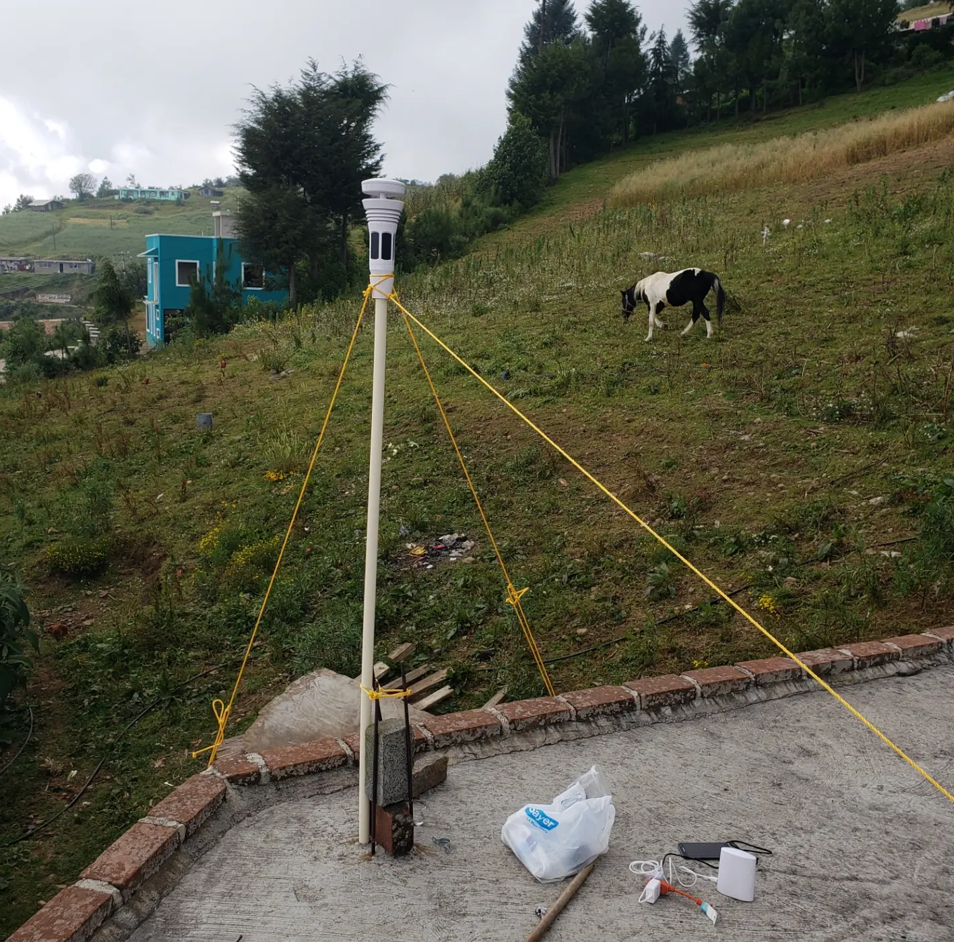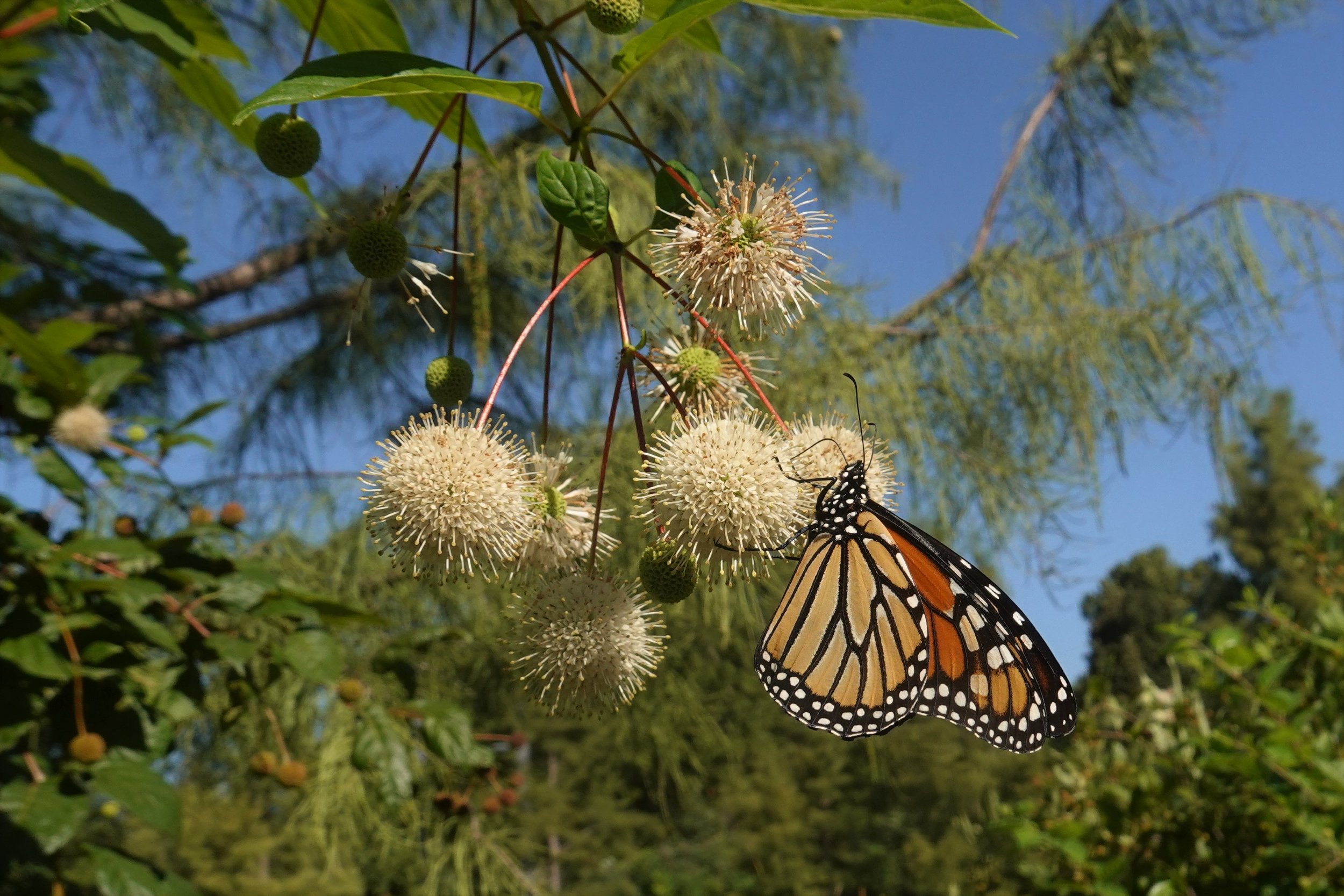by Sara Dykman
After six years of tangling my life with monarch butterflies, I don’t just know the facts of their migration, I feel the migration. I feel the relief a monarch mom feels finding milkweed. I feel the urgency of a hungry caterpillar munching a fine line between life and death. I feel the distance between natal land and winter refuge in my own tired legs.
I feel the victory a monarch feels finding an abundant field of flowers.
Still, one fact remained conceptual. I had yet to be in Mexico on the Day of the Dead and feel the monarchs return to a forest they had never been to before. On my 2017 bike tour I had been a straggler, nearly a month behind the leading edge of the migration. This year, on a motorcycle, I aimed to beat the wave of butterflies and be witness to their clockwork-like, miracle-esque arrival.
I was excited to be in Mexico as the monarchs started to arrive.
My journey, to arrive early, began with a 35-day, 30-presentation book tour, and ended with a seat-of-my-pants motorcycle marathon. I arrived at my friend’s house located a few miles from the El Rosario colony on an empty tank. My brain needed rest from a month of near-constant performing, socializing, and staying on schedule. My body needed rest after driving a motorcycle over 1,000 miles in two days. Even my motorcycle limped to the finished line. A small oil leak, a dying battery, and broken speedometer, odometer, and rear light all needed the attention of a mechanic.
My friends welcomed me back to my home away from home.
Instead of rest or repair, I went right to work setting up my monarch counting project. In 2020, I trained ten women living near the El Rosario colony to count monarchs three times daily. Their effort produced the first ever data set on monarch streaming, a behavior where monarchs leave their colony and fly up and down the mountains like a river of wings. This year, my goal was to continue the research while expanding the timeframe, study area, and number of participating women.
Lizbet lives near Angangeo and is one of the woman counting monarchs for the first time this year.
I created new data sheets for a new season of data collection.
The magnitude of this endeavor hit me hard as I jump-started my project. Even though I’ve biked across salt flats, canoed around barges, and walked 25 miles a day for four and a half months, I quickly learned that this project would be the most far-fetched adventure I’d ever done. Biking seemed easy when I compared it to teaching a woman that didn’t own a cellphone, in a language I’m still learning, how to troubleshoot a mobile hotspot internet connection for the weather station thermometer I installed on her roof.
Albertina counts monarchs while the thermometer on her roof records valuable data.
Troubleshooting these thermometers was a full time job.
But I am committed. I’d raised thousands of dollars to pay these women to gather never-before-collected data (but there is still plenty to raise). This money would help support families, and bring a more gentle economy, one that gave to rather than took from the monarchs. And so I rushed from site to site. I retrained women with new protocols and returned in quick succession to check in and answer questions. And walked with my head glued to the sky, like the dance of someone waiting for monarchs to arrive.
Erika, a woman counting in the community of Rancho Escondido, spotted the first monarchs of the season. On November 1st I answered my phone to her bubbling announcement about small dots high in the sky. “Son puntitas en el cielo!” She sounded as if she had just uncovered buried treasure, and I suppose she had. Tiny treasures glided into her life from distant lands, their value intrinsic and overflowing.
From afar the monarchs look like black specks in the sky.
The next day the treasures found me. As is customary on Dia de los Muertos, my friends and I were at the local cemetery paying tribute to their lost loved ones. My friend, Gloria, sprinkled marigold petals on the grave of her daughter, who had died two decades earlier. Pablo tidied the border with a hoe, and I arranged a bouquet of flowers in the bucket of water carried up from the creek. The work was serious, but it was performed with an energy as light as a butterfly. Despite the dead, the cemetery bustled with smiles and life. Around us, people carried flowers and buckets of water. Small groups huddled around gone-but-not-forgotten souls. Dogs trotted with purpose. A man hustled sugar-coated churros between the flowers and wreaths. Then, like a gift from the universe, a shadow caught my eye. I spun my head to the heavens. “Una monarca!” I gasped.
I saw my first monarch of the season at the local cemetery a few miles from the El Rosario sanctuary.
Over the last six years I have told thousands of people that the monarchs, once considered the souls of lost loved ones, arrive at their Oyamel fir forest on the Dead of the Dead. I have explained this over and over without fully understanding the magnitude of such precision. Now, thanks to a monarch that was something like the 25th-great-grandchild of the monarchs I had biked with, I began to understand. In the shadow of a tiny butterfly, I grasped the profound triumph inherent in a wispy bug surviving a thousand-plus mile voyage. “Como es posible?” I muttered to my friends who were both tracking the migrant across the sky. How was it possible that this animal had found this exact forest on this exact day?
How is it possible that this butterfly (born in the front yard of Val in Joplin, MO) will fly thousands of miles to a forest they have never been before.
I grabbed my camera to satisfy my instinct to capture proof of such a seemingly-impossible feat. The shutter clicked, but all I got was a blurry, silhouette punctuating a billowing cloud. My desire to document the moment was futile. One can’t capture the enormity of such an accomplishment with a camera.
One of many blurry photos of passing monarchs. I can’t help but try to document their success!
“Otra,” declared Gloria. I gave up on photography to stand with my friends and admire the passing of several more floppy orange butterflies. As Catholics, my friends don’t believe their baby girl’s soul occupied the creatures overhead. I’m not sure I believed it either, but I believe in the idea of it. The idea that a butterfly can connect us to those we loved, and remind us that when we hurt any being we are hurting our family.
I said nothing more. I didn’t want to explain or justify the intensity I felt. Instead I stole a moment of stilled silence to feel the victory, the relief, and the awe wrapped around each butterfly like an aura. They were so unique, each carrying a story as impossible as the next.
My thoughts flashed to memories of the monarchs I had seen since leaving Kansas City. There were the monarchs at schools, libraries, front yards, wild lands, and roadsides. There were the monarchs I tagged, and the ones who escaped my net. I wondered about each and every one, and considered the possibility we were meeting again.
There was a chance that I was seeing a monarch I had meet in a Texas parking lot.
Or perhaps I was seeing a monarch I had first seen at a city park in Oklahoma.
Of all the monarchs, I yearned for the one overhead to be the same one I spotted, weeks earlier, just north of Dallas. On a farm-to-table highway, now choked with sprawling traffic, I watched a monarch search for just-evicted flowers. Behind her bloomed the scars of new “development”. The land bled green grass, pavement, and ostentation greed. My heart broke watching her face this new reality. I had felt powerless, blinded by my own tears. But I was far from powerless. I had my voice, my time, my money, my vote, my love, and my anger to give. And I had hope. I held onto the hope that she would find a yard filled with native plants and grow fat in this hospitality. I carried this hope with me, and in the cemetery I hoped it was her overhead, alive and well.
I hoped every monarch had found the flowers they were looking for.
I hoped they had grow fat on our garden hospitality.
“Otra,” cried Gloria. Pablo echoed her, pointing out several more. My friends had turned finding monarchs into a game. I smiled and squinted to the sun. Tiny dots caught my attention. They moved southwest in a formation that might as well have spelled out, here we are, be amazed.
Every passing monarch added to my amazement, and in this amazement fact and feeling blurred. Luckily, you don’t need to bike ten thousand miles to feel the length of the migration. You don’t have to go hungry to feel the need to plant milkweed. You don’t have to visit a Mexican cemetery on November 2nd to feel the hope carried by arriving monarchs. All you need to do is go sit among your backyard milkweeds and wait for the monarchs to find you. And when they do, know that they have traveled far, braved much, and seen lots. Know that they are your family. Know that you are their home. Know that if you know this, then the feelings, which transcend fact, will find you too.
The butterflies can bring beauty and awe to our lives, but we must invite them in with native flowers.
Can you count the streaming monarchs?


















